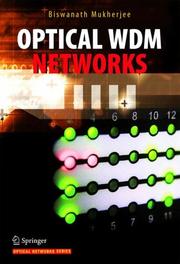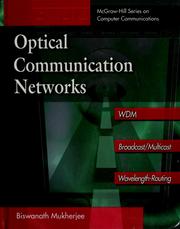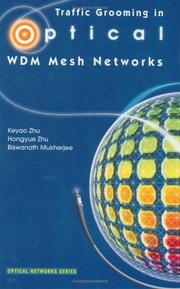| Listing 1 - 10 of 13 | << page >> |
Sort by
|

ISBN: 0387291881 0387290559 Year: 2006 Publisher: New York : Springer,
Abstract | Keywords | Export | Availability | Bookmark
 Loading...
Loading...Choose an application
- Reference Manager
- EndNote
- RefWorks (Direct export to RefWorks)
Research and development on optical wavelength-division multiplexing (WDM) networks have matured considerably. While optics and electronics should be used appropriately for transmission and switching hardware, note that "intelligence" in any network comes from "software," for network control, management, signaling, traffic engineering, network planning, etc.The role of software in creating powerful network architectures for optical WDM networks is emphasized. Optical WDM Networks is a textbook for graduate level courses. Its focus is on the networking aspects of optical networking, but it also includes coverage of physical layers in optical networks. The author introduces WDM and its enabling technologies and discusses WDM local, access, metro, and long-haul network architectures. Each chapter is self-contained, has problems at the end of each chapter, and the material is organized for self study as well as classroom use. The material is the most recent and timely in capturing the state-of-the-art in the fast-moving field of optical WDM networking.
Wavelength division multiplexing. --- WDM (Telecommunication) --- Multiplexing --- Optical communications --- Information Technology --- Computer Science (Hardware & Networks) --- Computer Communication Networks. --- Telecommunication. --- Computer network architectures. --- Computer engineering. --- Communications Engineering, Networks. --- Computer Systems Organization and Communication Networks. --- Electrical Engineering. --- Electric communication --- Mass communication --- Telecom --- Telecommunication industry --- Telecommunications --- Communication --- Information theory --- Telecommuting --- Computers --- Architectures, Computer network --- Network architectures, Computer --- Computer architecture --- Design and construction --- Computer architecture. Operating systems. --- Computer. Automation. --- informatica. --- Computer communication systems. --- Electrical engineering. --- Computer organization. --- Communication systems, Computer --- Computer communication systems --- Data networks, Computer --- ECNs (Electronic communication networks) --- Electronic communication networks --- Networks, Computer --- Teleprocessing networks --- Data transmission systems --- Digital communications --- Electronic systems --- Information networks --- Telecommunication --- Cyberinfrastructure --- Electronic data processing --- Network computers --- Organization, Computer --- Electronic digital computers --- Electric engineering --- Engineering --- Distributed processing
Book
ISBN: 3030162508 3030162494 Year: 2020 Publisher: Cham, Switzerland : Springer,
Abstract | Keywords | Export | Availability | Bookmark
 Loading...
Loading...Choose an application
- Reference Manager
- EndNote
- RefWorks (Direct export to RefWorks)
This handbook is an authoritative, comprehensive reference on optical networks, the backbone of today’s communication and information society. The book reviews the many underlying technologies that enable the global optical communications infrastructure, but also explains current research trends targeted towards continued capacity scaling and enhanced networking flexibility in support of an unabated traffic growth fueled by ever-emerging new applications. The book is divided into four parts: Optical Subsystems for Transmission and Switching, Core Networks, Datacenter and Super-Computer Networking, and Optical Access and Wireless Networks. Each chapter is written by world-renown experts that represent academia, industry, and international government and regulatory agencies. Every chapter provides a complete picture of its field, from entry-level information to a snapshot of the respective state-of-the-art technologies to emerging research trends, providing something useful for the novice who wants to get familiar with the field to the expert who wants to get a concise view of future trends.
Electrical engineering. --- Computer communication systems. --- Microwaves. --- Optical engineering. --- Communications Engineering, Networks. --- Computer Communication Networks. --- Microwaves, RF and Optical Engineering. --- Mechanical engineering --- Hertzian waves --- Electric waves --- Electromagnetic waves --- Geomagnetic micropulsations --- Radio waves --- Shortwave radio --- Communication systems, Computer --- Computer communication systems --- Data networks, Computer --- ECNs (Electronic communication networks) --- Electronic communication networks --- Networks, Computer --- Teleprocessing networks --- Data transmission systems --- Digital communications --- Electronic systems --- Information networks --- Telecommunication --- Cyberinfrastructure --- Electronic data processing --- Network computers --- Electric engineering --- Engineering --- Distributed processing --- Optical communications --- Communications, Optical --- Light communications --- Photonics

ISBN: 0070444358 Year: 1997 Publisher: New York (N.Y.) : McGraw-Hill,
Abstract | Keywords | Export | Availability | Bookmark
 Loading...
Loading...Choose an application
- Reference Manager
- EndNote
- RefWorks (Direct export to RefWorks)
Digital
ISBN: 9780387291888 Year: 2006 Publisher: Boston, MA Springer Science+Business Media, Inc
Abstract | Keywords | Export | Availability | Bookmark
 Loading...
Loading...Choose an application
- Reference Manager
- EndNote
- RefWorks (Direct export to RefWorks)
Electronics --- Mass communications --- Computer architecture. Operating systems --- Computer. Automation --- informatica --- computerbesturingssystemen --- elektronica --- OS (operating system) --- computernetwerken --- communicatietechnologie

ISBN: 9780387244990 0387244980 9780387244983 1441937498 0387244999 Year: 2005 Publisher: New York : Springer,
Abstract | Keywords | Export | Availability | Bookmark
 Loading...
Loading...Choose an application
- Reference Manager
- EndNote
- RefWorks (Direct export to RefWorks)
Survivable Optical WDM Networks investigates different approaches for designing and operating an optical network with the objectives that (1) more connections can be carried by a given network, leading to more revenue, and (2) connections can recover faster in case of failures, leading to better services. Different networks -- wavelength-routed WDM networks, wavelength-routed WDM networks with sub-wavelength granularity grooming, and data over next-generation SONET/SDH over WDM networks -- are covered. Different approaches are proposed to explore every aspect of a protection scheme such as: (1) Protection granularity a. At wavelength granularity b. At sub-wavelength granularity (2) Protection entity a. Path protection b. Sub-path protection c. Segment protection (3) Routing a. Single-path routing b. Multi-path routing Tradeoffs between different objectives, e.g., resource efficiency vs. recovery time, are explored and practical approaches are proposed and analyzed. ---------------------------------------------------------- Canhui (Sam) Ou received a Ph.D. degree from the University of California, Davis, in 2004. His technical interests include WDM networks, MPLS, optical Ethernet, and FTTx. He is a Principal Member of Technical Staff at SBC Communications, Inc. He worked at Sprint Advanced Technology Laboratories and Fujitsu Laboratories of America as an intern. Biswanath Mukherjee received a Ph.D. degree from University of Washington, Seattle, in 1987. In 1987, he joined the University of California, Davis, where he has been Professor of computer science since 1995, and served as Chairman of computer science during 1997-2000. He is author of Optical Communication Networks book. He is a Member of the Board of Directors of IPLocks, a Silicon Valley startup company. He has consulted for and served on the Technical Advisory Board of a number of startup companies in optical networking. His research interests include lightwave networks, network security, and wireless networks. Dr. Mukherjee is winner of the 2004 Distinguished Graduate Mentoring Award from UC Davis. He serves or has served on the Editorial Boards of the IEEE/ACM Transactions on Networking, IEEE Network, ACM/Baltzer Wireless Networks (WINET), Photonic Network Communications, and others. He also served as Editor-at-Large for optical networking and communications for the IEEE Communications Society. He served as the Technical Program Chair of the IEEE INFOCOM’96 Conference.
Engineering. --- Communications Engineering, Networks. --- Computer Communication Networks. --- Microwaves, RF and Optical Engineering. --- Optics, Optoelectronics, Plasmonics and Optical Devices. --- Electrical Engineering. --- Computer engineering. --- Microwaves. --- Telecommunication. --- Ingénierie --- Réseaux d'ordinateurs --- Ordinateurs --- Micro-ondes --- Télécommunications --- Conception et construction --- Optical communications. --- Technology. --- Wavelength division multiplexing. --- Wavelength division multiplexing --- Optical communications --- Electrical & Computer Engineering --- Engineering & Applied Sciences --- Telecommunications --- Electrical Engineering --- Communications, Optical --- Light communications --- WDM (Telecommunication) --- Computer communication systems. --- Electrical engineering. --- Optical engineering. --- Optics, Lasers, Photonics, Optical Devices. --- Photonics --- Telecommunication --- Multiplexing --- Computers --- Hertzian waves --- Electric waves --- Electromagnetic waves --- Geomagnetic micropulsations --- Radio waves --- Shortwave radio --- Electric communication --- Mass communication --- Telecom --- Telecommunication industry --- Communication --- Information theory --- Telecommuting --- Design and construction --- Lasers. --- Photonics. --- New optics --- Optics --- Light amplification by stimulated emission of radiation --- Masers, Optical --- Optical masers --- Light amplifiers --- Light sources --- Optoelectronic devices --- Nonlinear optics --- Optical parametric oscillators --- Mechanical engineering --- Communication systems, Computer --- Computer communication systems --- Data networks, Computer --- ECNs (Electronic communication networks) --- Electronic communication networks --- Networks, Computer --- Teleprocessing networks --- Data transmission systems --- Digital communications --- Electronic systems --- Information networks --- Cyberinfrastructure --- Electronic data processing --- Network computers --- Electric engineering --- Engineering --- Distributed processing
Book
ISBN: 9780387291888 Year: 2006 Publisher: Boston, MA Springer Science+Business Media, Inc.
Abstract | Keywords | Export | Availability | Bookmark
 Loading...
Loading...Choose an application
- Reference Manager
- EndNote
- RefWorks (Direct export to RefWorks)
Research and development on optical wavelength-division multiplexing (WDM) networks have matured considerably. While optics and electronics should be used appropriately for transmission and switching hardware, note that "intelligence'' in any network comes from "software,'' for network control, management, signaling, traffic engineering, network planning, etc.The role of software in creating powerful network architectures for optical WDM networks is emphasized. Optical WDM Networks is a textbook for graduate level courses. Its focus is on the networking aspects of optical networking, but it also includes coverage of physical layers in optical networks. The author introduces WDM and its enabling technologies and discusses WDM local, access, metro, and long-haul network architectures. Each chapter is self-contained, has problems at the end of each chapter, and the material is organized for self study as well as classroom use. Highlights Include: Coverage of broadband access, optical burst switching (OBS), and optical metropolitan networks. Extensive treatment of "impairment-aware routing" and other timely topics such as "traffic grooming." Modern coverage of network control and management, as well as optical network survivability and "light-trees." The material is the most recent and timely in capturing the state-of-the-art in the fast-moving field of optical WDM networking.
Electronics --- Mass communications --- Computer architecture. Operating systems --- Computer. Automation --- informatica --- computerbesturingssystemen --- elektronica --- OS (operating system) --- computernetwerken --- communicatietechnologie

ISBN: 1280312300 9786610312306 0387270981 0387254323 1441937951 Year: 2005 Publisher: New York : Springer,
Abstract | Keywords | Export | Availability | Bookmark
 Loading...
Loading...Choose an application
- Reference Manager
- EndNote
- RefWorks (Direct export to RefWorks)
Traffic Grooming in Optical WDM Mesh Networks captures the state-of-the-art in the design and analysis of network architectures, protocols, and algorithms for implementing efficient traffic grooming in optical WDM mesh networks. Key topics include: * Static traffic grooming * Dynamic traffic grooming * Grooming models and policies * Grooming node architectures * Design of grooming network * Traffic grooming in next-generation SONET/SDH networks The authors investigate traffic-grooming problems in optical WDM mesh networks from various aspects. They cover static and dynamic traffic grooming, as well as grooming policies for both environments. A fundamental graph model for traffic-grooming networks is proposed. A variety of grooming-node architectures are examined and their performances compared. Design of traffic-grooming networks using different node architectures is explored, and traffic grooming in next-generation SONET/SDH networks is presented.
Wavelength division multiplexing. --- Optical communications. --- Communications, Optical --- Light communications --- Photonics --- Telecommunication --- WDM (Telecommunication) --- Multiplexing --- Optical communications --- Telecommunication. --- Computer Communication Networks. --- Microwaves. --- Communications Engineering, Networks. --- Microwaves, RF and Optical Engineering. --- Electric communication --- Mass communication --- Telecom --- Telecommunication industry --- Telecommunications --- Communication --- Information theory --- Telecommuting --- Hertzian waves --- Electric waves --- Electromagnetic waves --- Geomagnetic micropulsations --- Radio waves --- Shortwave radio --- Electrical engineering. --- Computer communication systems. --- Optical engineering. --- Mechanical engineering --- Communication systems, Computer --- Computer communication systems --- Data networks, Computer --- ECNs (Electronic communication networks) --- Electronic communication networks --- Networks, Computer --- Teleprocessing networks --- Data transmission systems --- Digital communications --- Electronic systems --- Information networks --- Cyberinfrastructure --- Electronic data processing --- Network computers --- Electric engineering --- Engineering --- Distributed processing
Digital
ISBN: 9780387270982 Year: 2005 Publisher: Boston, MA Springer Science+Business Media, Inc
Abstract | Keywords | Export | Availability | Bookmark
 Loading...
Loading...Choose an application
- Reference Manager
- EndNote
- RefWorks (Direct export to RefWorks)
Book
ISBN: 9780387270982 Year: 2005 Publisher: Boston, MA Springer Science+Business Media, Inc.
Abstract | Keywords | Export | Availability | Bookmark
 Loading...
Loading...Choose an application
- Reference Manager
- EndNote
- RefWorks (Direct export to RefWorks)
Traffic Grooming in Optical WDM Mesh Networks captures the state-of-the-art in the design and analysis of network architectures, protocols, and algorithms for implementing efficient traffic grooming in optical WDM mesh networks. Key topics include: * Static traffic grooming * Dynamic traffic grooming * Grooming models and policies * Grooming node architectures * Design of grooming network * Traffic grooming in next-generation SONET/SDH networks The authors investigate traffic-grooming problems in optical WDM mesh networks from various aspects. They cover static and dynamic traffic grooming, as well as grooming policies for both environments. A fundamental graph model for traffic-grooming networks is proposed. A variety of grooming-node architectures are examined and their performances compared. Design of traffic-grooming networks using different node architectures is explored, and traffic grooming in next-generation SONET/SDH networks is presented.
Digital
ISBN: 9780387745183 Year: 2008 Publisher: Boston, MA Springer Science+Business Media, LLC
Abstract | Keywords | Export | Availability | Bookmark
 Loading...
Loading...Choose an application
- Reference Manager
- EndNote
- RefWorks (Direct export to RefWorks)
| Listing 1 - 10 of 13 | << page >> |
Sort by
|

 Search
Search Feedback
Feedback About UniCat
About UniCat  Help
Help News
News